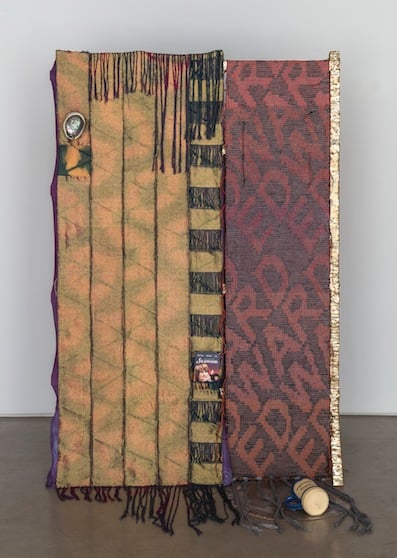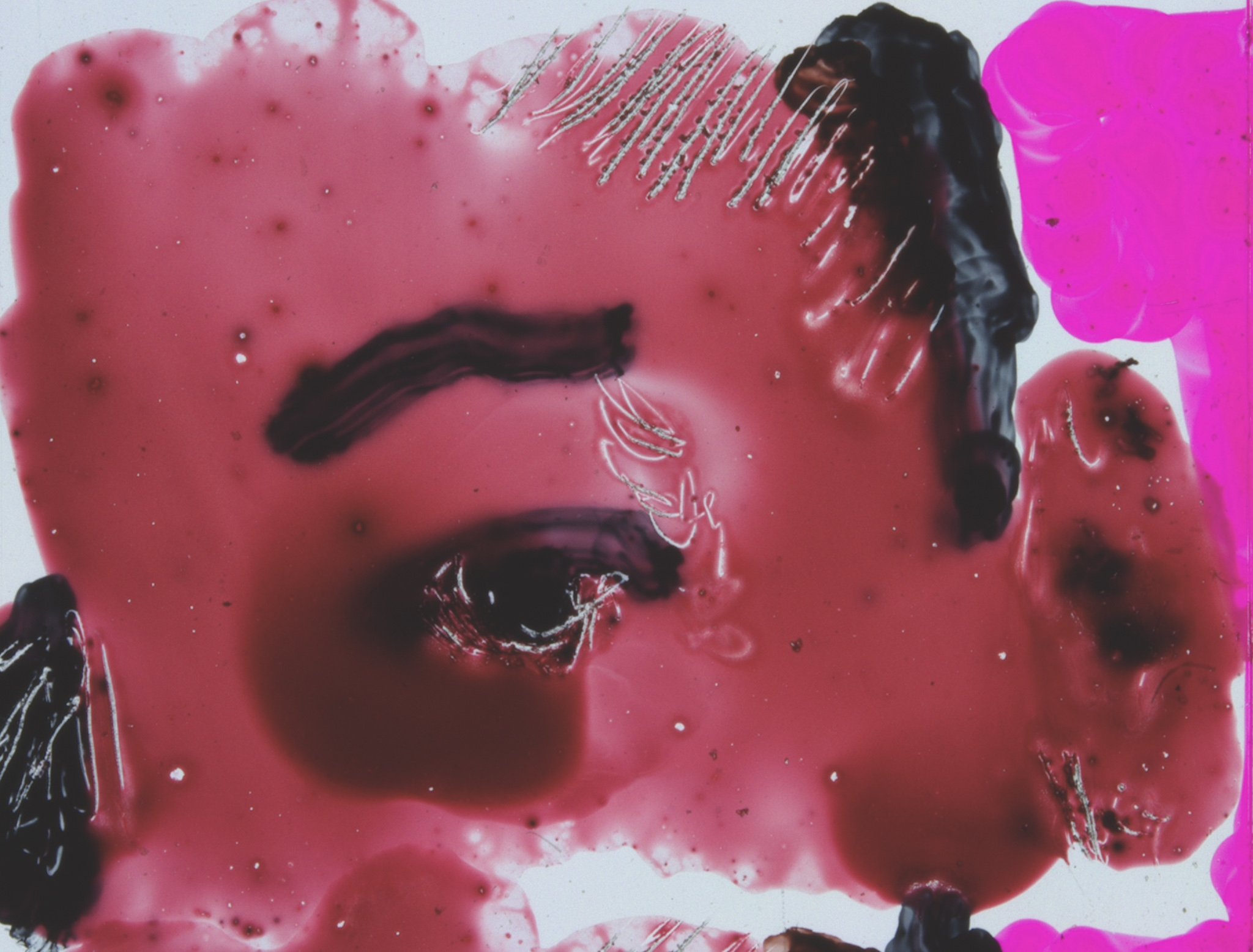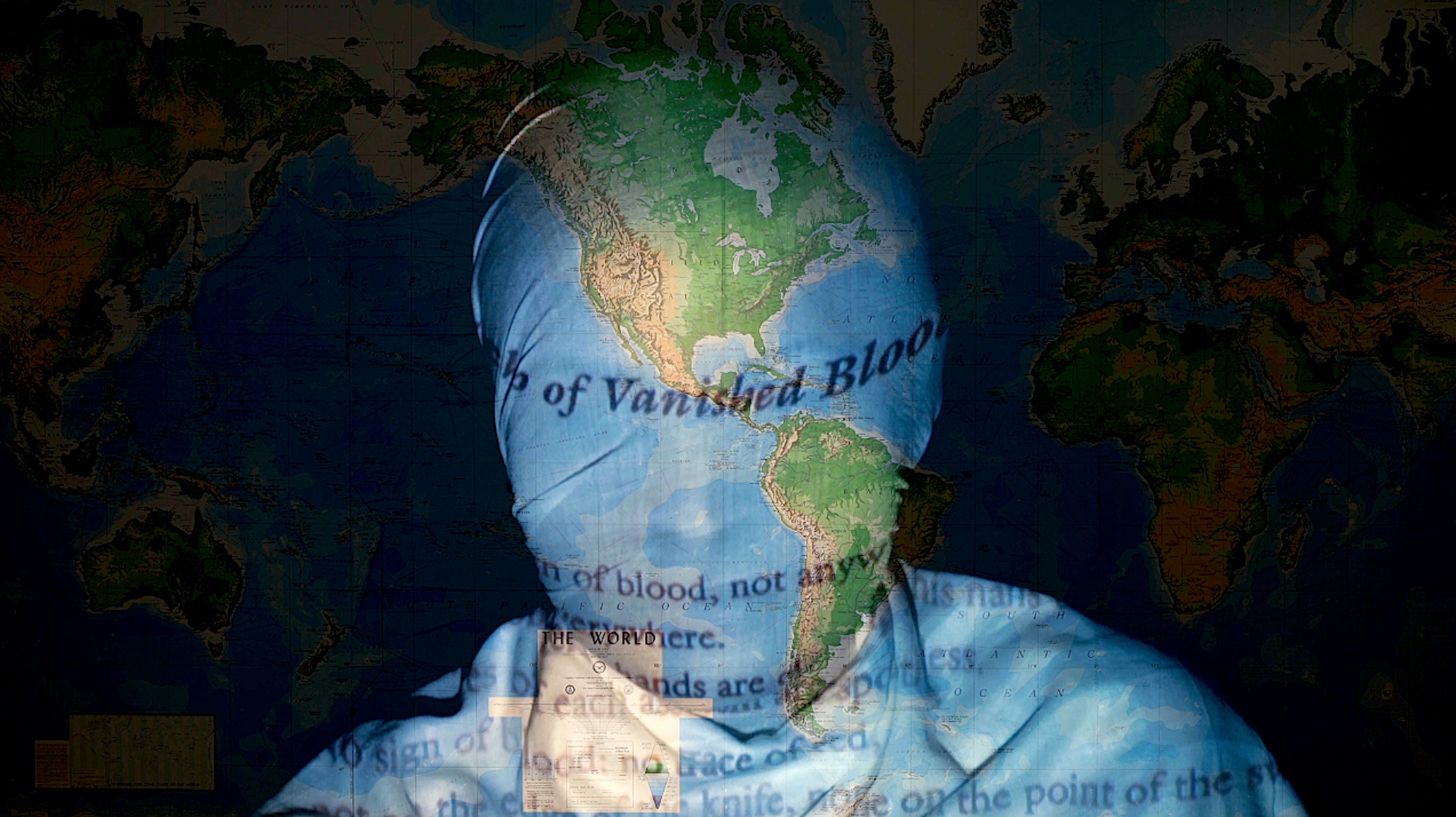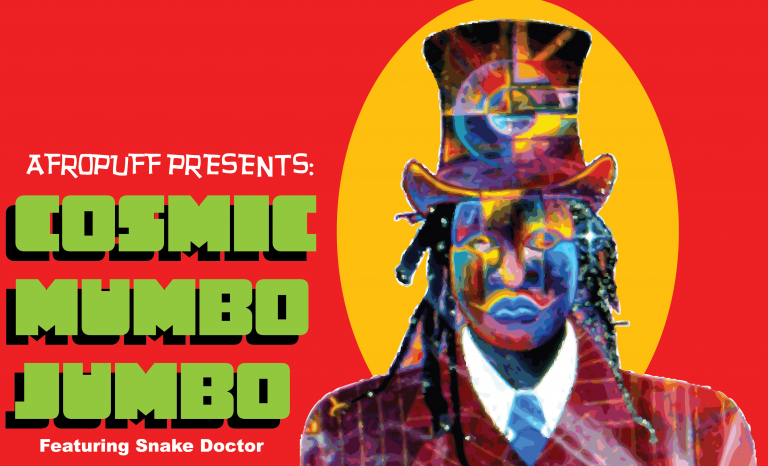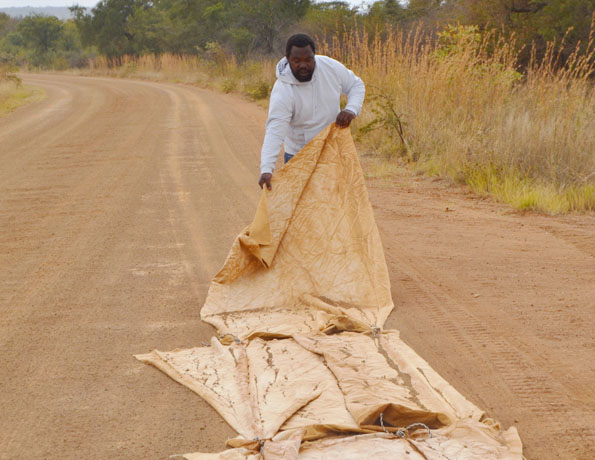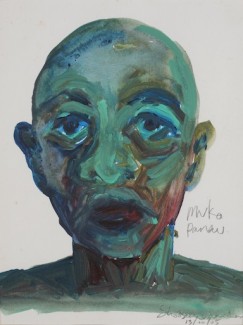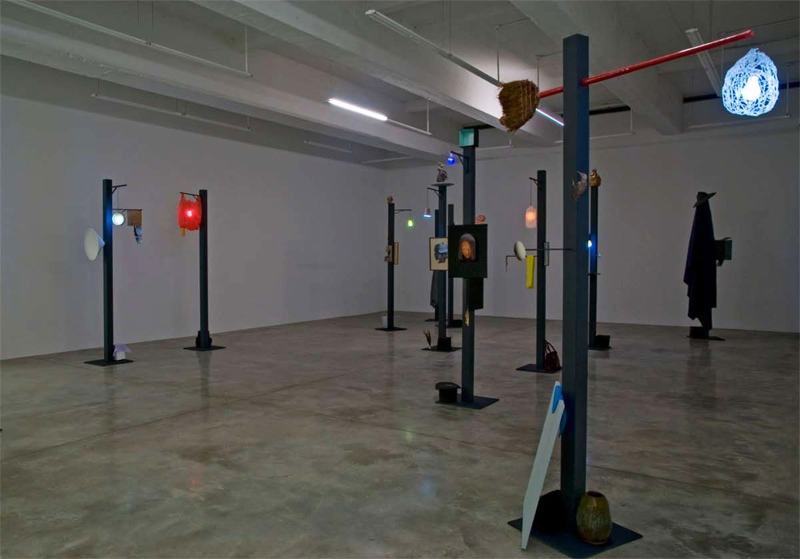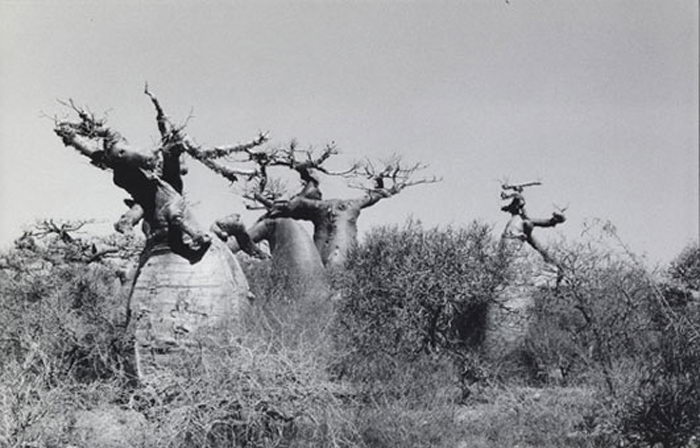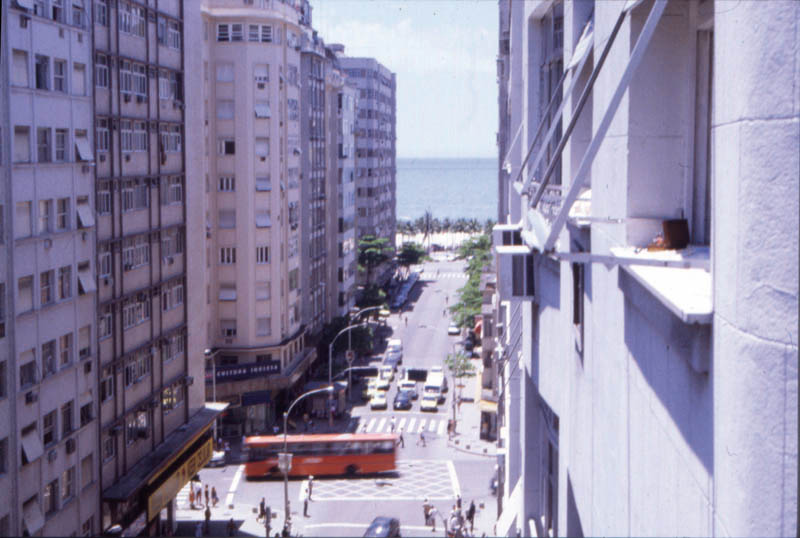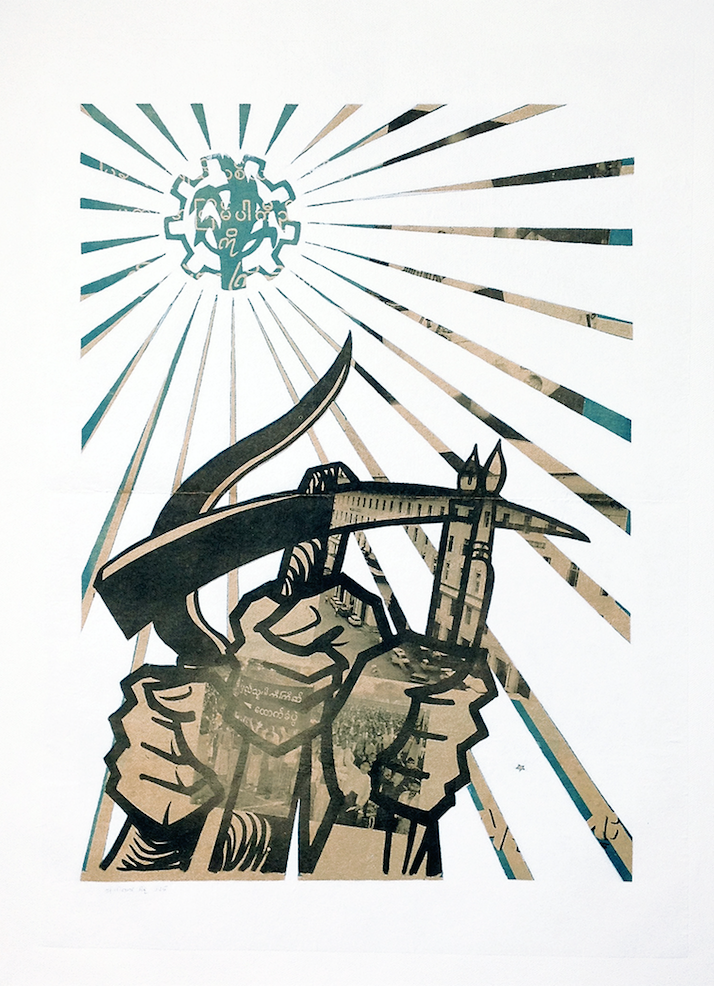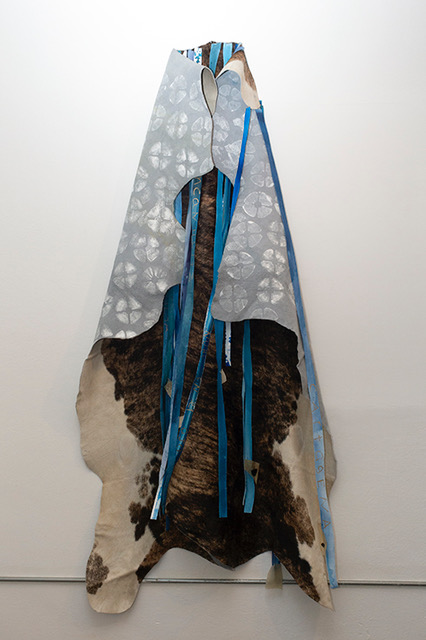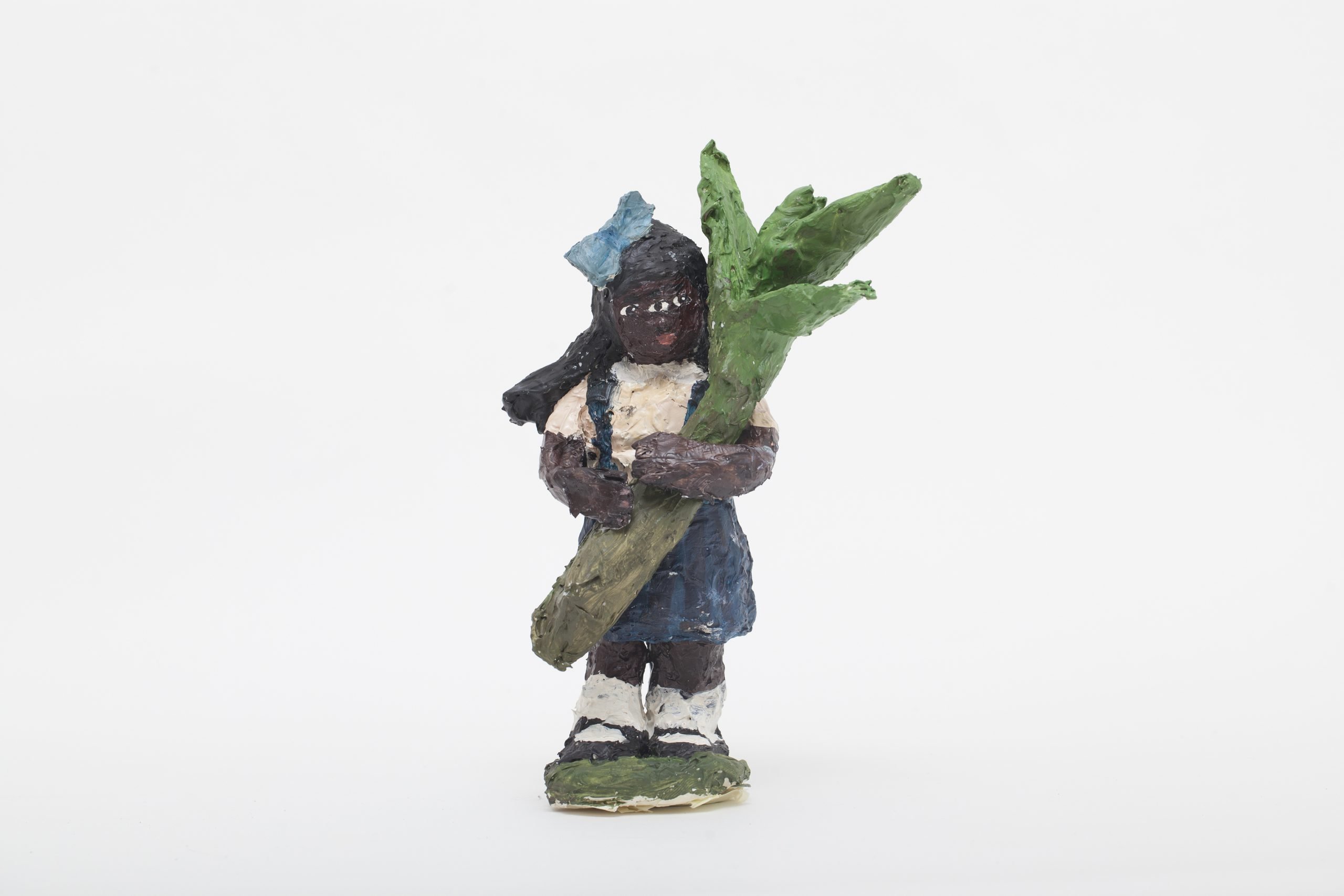
© » KADIST
Kelly Sinnapah Mary
Notebook 10 , l ‘enfance de sanbras (The Childhood of Sanbras) series by Kelly Sinnapah Mary is a sequel to an earlier series by the artist titled Cahier d’un non retour au pays natal (2015). This earlier work considers the process of reconstructing an identity of the Indian workers who arrived in the Caribbean during the post-slavery period. The work addresses the conditions of recruitment of these Indian workers, the strategies of the recruiters, how they lured them onto ships to bring them back to the plantations.

© » KADIST
Amapola Prada
In the video Unit/y we see Amapola Prada in the center of the screen wearing an oversized, worn out sweatshirt, socks and flip-flops—standing motionless on a dimly lit street in her native Lima, Peru. As the video progresses, people, stray dogs, and cars pass by unbeknown to her presence, inescapably fulfilling their roles in the everyday. The title of the work gives us a clue.

© » KADIST
Kelly Sinnapah Mary
Notebook 10 , l ‘enfance de sanbras (The Childhood of Sanbras) series by Kelly Sinnapah Mary is a sequel to an earlier series by the artist titled Cahier d’un non retour au pays natal (2015). This earlier work considers the process of reconstructing an identity of the Indian workers who arrived in the Caribbean during the post-slavery period. The work addresses the conditions of recruitment of these Indian workers, the strategies of the recruiters, how they lured them onto ships to bring them back to the plantations.

© » KADIST
Majd Abdel Hamid
Tadmur by artist Majd Abdel Hamid is influenced by a book by Mustafa Khalifa titled The Shell: Memoirs of a Hidden Observer , which details Khalifa’s imprisonment in the Assad ‘desert prison’ Tadmur. Khalifa’s compelling testimonial is now considered to have enlightened the Syrian public to the atrocities being committed in their country by the Assad regime and catalyzed a political resurgence in Syria. The prison was destroyed by ISIS in 2015 and though the initial reaction by the Syrian public was largely positive, the complete leveling of the prison erases the brutal experiences of the prisoners, many of whom died and those that survived.

© » KADIST
Abel Rodríguez
Abel Rodríguez’s precise, botanical illustrations are drawn from memory and knowledge acquired by oral traditions. They are the visions of someone who sees the potential of plants as food, material for dwellings and clothing, and for use in sacred rites. Terraza Alta V is part of a series of drawings that track the changing appearance and life of an area identified as Terraza Alta.

© » KADIST
Kelly Sinnapah Mary
Notebook 10 , l ‘enfance de sanbras (The Childhood of Sanbras) series by Kelly Sinnapah Mary is a sequel to an earlier series by the artist titled Cahier d’un non retour au pays natal (2015). This earlier work considers the process of reconstructing an identity of the Indian workers who arrived in the Caribbean during the post-slavery period. The work addresses the conditions of recruitment of these Indian workers, the strategies of the recruiters, how they lured them onto ships to bring them back to the plantations.

© » KADIST
Hikaru Fujii
The film The Anatomy Classroom is part of a research project developed by Hikaru Fujii around objects and artifacts evacuated from the Futaba Town Museum of History and Folklore, which is located in the “difficult-to-return zone” since the Fukushima Daiichi nuclear accident. In order to avoid radioactive contamination and biological damage, the objects have been removed from the museum, where they were once part of a collection that the curator had developed over twenty years to represent the local community and its long history on the land. Fujii has been closely following the movements of these historical objects, while organizing visits to the site and hosting discursive events on the crisis of memory and culture.

© » KADIST
Cynthia Gutiérrez
Estratos II by artist Cynthia Gutiérrez features a large white plinth with a transversal cut through the lower half, revealing a collection of archeological objects. These pieces of history have seemingly been lost to time and have lived covered under a sterile exterior. To create the ceramic objects for this project, Gutiérrez worked closely with an artist that creates Mesoamerican replicas.

© » KADIST
Cao Shu
The installation Infinity and Infinity Plus One by Cao Shu is a modern fable of destruction, collective consciousness, and future memory told through the lens of a seaside hotel erected in the 1990s on an island in China. Combining 3D-rendered images and shot footage, the work travels through a seemingly-unlimited number of rooms, infinite corridors, and breathtaking viewpoints on site. Meanwhile, an official voiceover tells an absurd story about philosophy and mathematics in the form of a monologue.

© » KADIST
Bili Bidjocka
The short two-channel video Pause/Tanmpo takes its cue from a coincidental encounter artist Bili Bidjocka had in Dakar. Walking down the corniche, he saw a boxer, a Senefalese man, training at the beach. It immediately reminded the artist of Le Boxeur—the most well-known brand of matchsticks in Cameroon.

© » KADIST
Wang Mowen
In Trinity , Wang Mowen uses video to tell the story of a young woman who wants to know the whereabouts of a person born sixty years ago. She visits three fortune tellers and provides the person’s birth date. Each psychic deliberates and comes to the correct conclusion that the woman in question is the seeker’s mother.

© » KADIST
Maya Watanabe
In Escenarios (Sceneries) Maya Watanabe films forgotten wastelands through a series of 360° camera movements that highlight the dramatism and visual richness of terrain that would be otherwise forgotten. Her choice to depict these lands is a reference to the devastated geography that now grips her Peru after decades of destruction from a grueling Civil War—the second largest internal conflict in the history of Latin America. Through the videos of this post-conflict territory she alludes at once to the sombre episode in Peru’s recent history, as well as her memory of it: fragmented and contused.

© » KADIST
Diego Marcon
Monelle by Diego Marcon was filmed at night inside the infamous Casa del Fascio, the headquarters of the local Fascist Party in Como Italy, designed by Giuseppe Terragni under Mussolini’s rule. The building is immersed in darkness and it is initially difficult to recognize the iconic rationalist architecture, flashes of light illuminate languid adolescent girls sleeping amidst the space for just a few seconds at a time. Next to the bodies, strange humanoids are lurking, they are CGI-generated, but the human eye does not have enough time to register their artificiality, they materialize and disappear in a flash like ghosts.

© » KADIST
Aimée Zito Lema
Rond de Jambe by Aimée Zito Lema is a series formed by two works: a three-channel video installation and a live performance. Each component in this project approaches the same subject matter through a different medium in order to investigate politics as they are made manifest in and through the body. Using archival footage of protests of the Stopera building project in Amsterdam as a starting point, artist Aimée Zito Lema worked with dancers to translate the protest movements into a choreography.

© » KADIST
Jorge Julián Aristizábal
Drawing & Print (Drawing & Print)
La Masacre de el Aro (The Massacre of El Aro) by Jorge Julián Aristizábal refers to a massacre in Colombia which occurred on October 22, 1997 in the municipality of Ituango, Department of Antioquia. On this day, 15 individuals accused of being leftist supporters of FARC were massacred by paramilitary groups. Perpetrators also raped women, burned down 43 houses, stole cattle and forcibly displaced 900 people.

© » KADIST
Ha Tae-Bum
Ha Tae-Bum’s “White” series, started in 2008, begins with photographic images from the mainstream media depicting sites of conflict or crisis. The artist eliminates human presence, miscellaneous details, and all color from the images, then “rebuilds” them into quiet, achromatic models with thin white paper. Once complete, the models are photographed in a nearly identical composition as the original image.
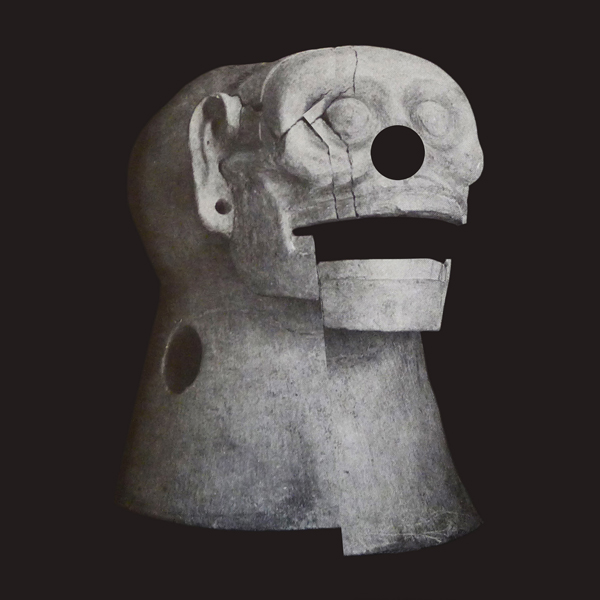
© » KADIST
Ana Roldán
Ana Roldán’s Displacements works use images taken from a 1970s exhibition catalogue for an exhibition called The Death in Mexico. Using pre-Columbian objects and other artifacts from Mexican history, the exhibition aimed to explore various representations of death in the Mexican cultural tradition. Roldán’s works begin with these rich black-and-white photographs and break them apart into fragments, slicing and dismembering the artifacts they depict.

© » KADIST
Tom Nicholson
Tom Nicholson’s Comparative Monument (Palestine) engages a peculiar Australian monumental tradition: war monuments that bear the name “Palestine”. Countless of these monuments were built immediately after World War 1 to commemorate the presence of Australian troops in Palestine. The Australian troops had entered Palestine in 1917 after fighting the Turks threatening the Suez Canal with the British, when the main focus was on the European fronts rather than on the Middle East campaign.
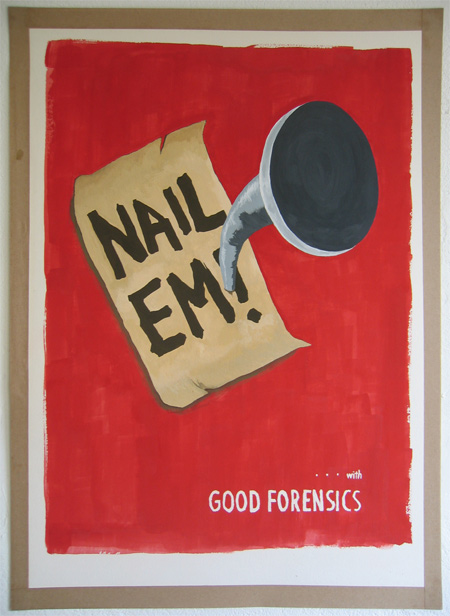
© » KADIST
Mike Cooter
Drawing & Print (Drawing & Print)
Forensic Poster was first realized in 2006 and reactivated in 2011; its making consisted of the artist visiting the London School of Criminology and corresponding with the interim director there in order to reproduce a poster by memory. This piece of work is symptomatic of Cooter’s projects which are often arduous enterprises littered with pitfalls, since they imply prospecting and collaborating with third parties whose will determine the success of the project. Forensic Poster consists of a letter, emails and a gouache which translates the artist’s attempt to recreate a poster glimpsed at in one of the study halls of the London Police Department of Forensic Medicine.

© » KADIST
Kadar Brock
Kadar Brock creates dynamic abstract paintings that are born from a process of painting, scraping, priming, sanding, and painting again. Retaining a commitment to his established process, Brock layers paintings about personal memory, family history, and iconographies of New Age religion, alongside representations of masculinities found in the characters of American and Japanese comic books and film. The physical and emotional process of creation, often taking place over many years, enables a reverse archaeology of the self and renders a delicate balance between body, memory, and psychology.

© » KADIST
Rebecca Quaytman
R. H. Quaytman’s family on her father’s side is of Jewish heritage from Poland. In the summer of 2016, Quaytman traveled to Poland to research an upcoming retrospective exhibition taking place in Warsaw and ?ódz, the town from which her great-grandfather emigrated to the United States. Tracing her grandfather’s and great-grandfather’s origins, Phocis Pole is from a series of paintings that explores her paternal lineage.

© » KADIST
YOUNG-HAE CHANG HEAVY INDUSTRIES
To the syncopations of a jazzy soundtrack, Korean words in white against a black background flashes between an English dialogue in black text against white ground. Comprised of curt lines such as “forever” “failure” “to live,” the Korean forms non-sequiturs and double entendres to the English script following a line of questioning between a detective and a victim telling a meandering story surrounding a bullet being in a wrist, going to hospital, traveling to Japan, and the discovery of a love triangle. This narrative of a potentially grave situation is told in a nonchalant manner.
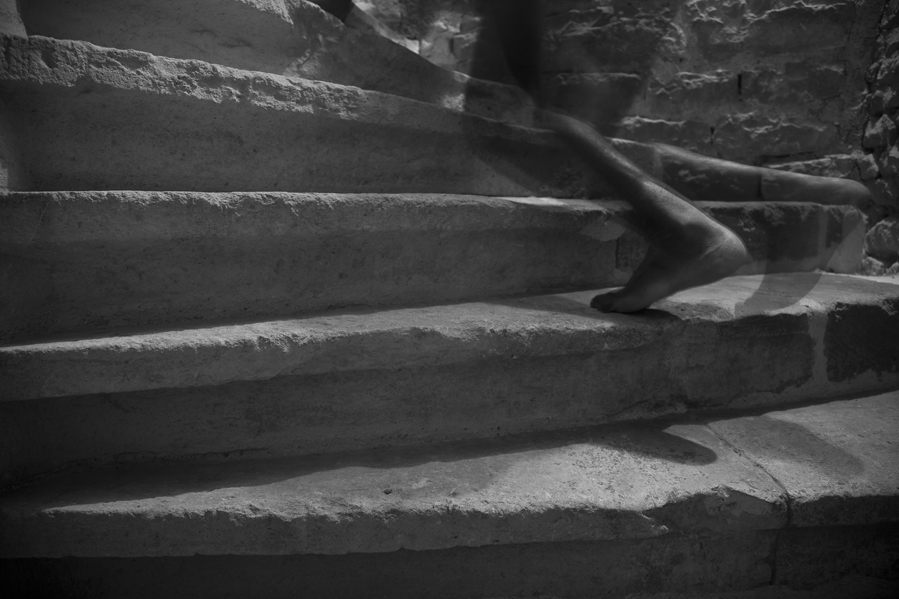
© » KADIST
Em'kal Eyongakpa
Em’kal Eyongakpa was born in Cameroon in 1981. After obtaining a postgraduate diploma in Botany and Ecology, he decided to concentrate exclusively on visual and sound art. His use of poetic, symbolic and surrealistic imagery is often sprinkled with paradoxes that challenge the obvious.

© » KADIST
Aslan Goisum
The video work Volga by Aslan Goisum begins with a sweeping field caught under a misty, gray sky. In the center of the frame is a white car of the eponymous Soviet make—standard-issue for the imperial administrative class during the USSR’s ‘Period of Stagnation.’ The vehicle is the only indication of cultural geography in the video; what unfolds must be somewhere in the former USSR. In a slow crescendo of activity and tension, small groups of men, women, and children, walk up to the car and squeeze into it.

© » KADIST
Voluspa Jarpa
In her work, Fantasmática Latinoamericana, Jarpa works from photographs of five public funeral processions following the mysterious deaths of five Latin American presidents. Depicting the crowds and the caskets in grey tones, Jarpa’s paintings underscore the wide impact of these tragic events on the people and politics of the region. Voluspa Jarpa’s work is based upon a meticulous analysis of political, historical, and social documents from Chile and other Latin American countries, which she uses to develop a reflection on the concept of memory.

© » KADIST
Cici Wu
Unfinished Return of Yu Man Hon by Cici Wu is delicate, but physically much more robust than Cici Wu’s earlier works. What continues is the sense of longing, of something unresolved; it is haunting, like the images from a dream that we try to remember upon waking up. Unfinished Return of Yu Man Hon revolves around the story of a developmentally challenged young boy, who purportedly disappeared during the handover of Hong Kong by the British to Chinese governance.

© » KADIST
Reza Aramesh
The photographed plaster heads set against the idyllic landscapes of the south of England, subvert the process of image production and memory. Based on photographic sources from journalism, they have preserved a ‘memento mori’ in the intimate form of a sculpture, yet derived from a source which is not only public but also voyeuristic. They have been entirely dislocated from their original context, and transferred to the realm of photography again, into fragile silver gelatin prints.

© » KADIST
Mateo Lopez
Mateo Lopez uses paper as a medium to conjure personal experiences. The artist creates drawings and trompe l’oeil objects, ranging from apples to clothing hangers to doors. These props are part of a performance; he often sets up his studio in public and uses cues from his own journeys as the inspiration for his work.

© » KADIST
Shilpa Gupta
Drawing & Print (Drawing & Print)
These hand drawn maps are part of an ongoing series begun in 2008 in which Gupta asks ordinary people to sketch outlines of their home countries by memory. Gupta created each map by superimposing 100 separate drawings of each country. The project investigates modern notions of the nation-state, national identity, and borders by looking at countries in which boundaries are contested and the history of the land far precedes such ideas.
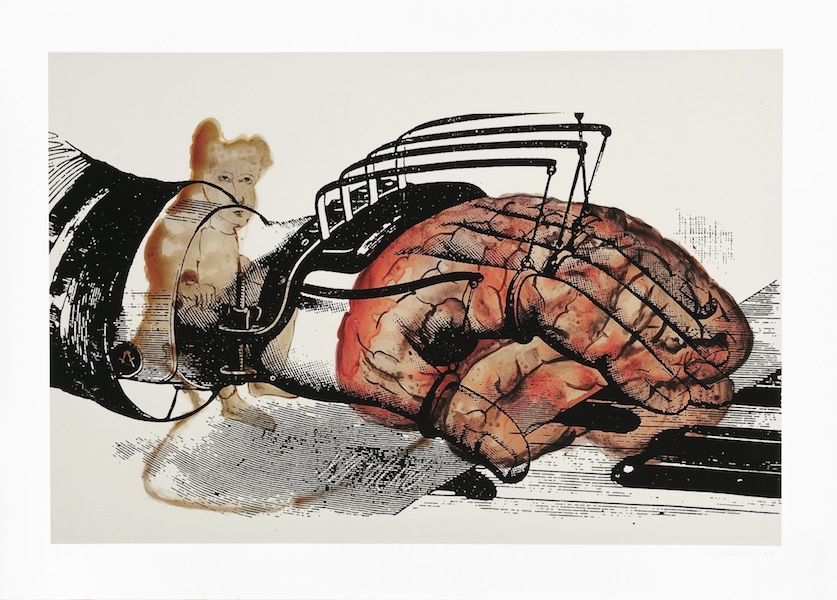
© » KADIST
Nalini Malani
Memory: Record/Erase is a stop-motion animation by Nalini Malani based on ‘The Job,’ a short story by celebrated German poet and playwright Bertolt Brecht. Brecht’s story follows a poverty-stricken family during the German depression, as the central character, Frau Hausmann, is forced to impersonate her late husband to procure his job as a nightwatchman to support her two children. Despite her exceptional performance during the job, and even after receiving public commendation for catching a thief, when eventually her identity is discovered during a factory accident she is forced into a precarious existence where she resorts to selling herself to get by.
Kelly Sinnapah Mary
Kelly Sinnapah Mary is a multidisciplinary artist who’s work is informed by the diasporic journey of her ancestors...
Amapola Prada
As the daughter of an actor, Amapola Prada recalls frequently attending the theater as a child and noticing that she never saw herself (her body or reality) represented...
Rebecca Quaytman
In her work, Rebecca Quaytman displays great interest in the dissolution of the image...
Harit Srikhao
Harit Srikhao perceives photography as a culturally determined medium...
Joana Hadjithomas & Khalil Joreige
Joana Hadjithomas and Khalil Joreige collaborate as both filmmakers and artists, producing cinematic and visual artwork that intertwine, spanning feature and documentary films, video and photographic installations, sculpture, performance lectures and texts...
Nidhal Chamekh
Based between his native Tunis and Paris, Nidhal Chamekh’s work is an investigation into history as a point of access to our contemporary times...
Natalia Lassalle-Morillo
Natalia Lassalle-Morillo’s films explore familial, neighborly, and citizen relationships in the context of Puerto Rico’s fraught history with the United States and the resulting imperialist oppression that has altered generations of families’ material and spiritual trajectories...
Reza Aramesh
Working across a wide range of materials and processes, Aramesh examines simultaneously the history of Western art and contemporary commentary on the politics and history of the Middle East, concocting a unique visual language to address the contemporary conditions of violence and bio-politics...
Jane Jin Kaisen and Guston Sondin-Kung
Working with narrative experimental film, multi-channel video installation, performative video art, photography, and text, Jane Jin Kaisen engages themes of memory, trauma, migration and translation at the intersection of personal and collective histories...
Basma Alsharif
Basma Alsharif is an artist and filmmaker of Palestinian origin, born in Kuwait, and raised between France, the US and the Gaza Strip...
Nazgol Ansarinia
- location: Tehran, Îran
- year born: 1979
- gender: female
- nationality: Iranian
Manuel Correa
Manuel Correa’s practice deals with the reconstruction of post-conflict intergenerational memory in contemporary societies...
Ren Zi
Ren Zi turned to art after having spent his working life in the business of words, having previously worked in advertising...
Carolina Caycedo
Carolina Caycedo’s work triumphs environmental justice through demonstrations of resistance and solidarity...
Josh Faught
American artist Josh Faught uses weaving, knitting, and crochet as means to making in his textured and evocative sculptures...
Lotus Laurie Kang
Lotus Laurie Kang works with sculpture, photography, and site-responsive installation...
Majd Abdel Hamid
Palestinian artist Majd Abdel Hamid’s work is akin to an archeology of violence and trauma from which he unearths the materials that weave a web of new imagination...
Diego Marcon
Diego Marcon uses film, video and installation to investigate the ontology of the moving image, focusing on the relationship between reality and representation...
Kadar Brock
Kadar Brock makes large-scale abstract paintings via a rigorous process of layering, erasing, and reworking his surfaces; his highly textured canvases are variously discordant, exuberant, and topographical in nature...
Nguyen Thai Tuan
Nguyen Thai Tuan was born in 1965, he studied at the school of Fine Arts of Hue where he studied propaganda art, which he got bored of very quickly...
Julio Cesar Morales
- location: San Francisco, California
- year born: 1966
- gender: male
- nationality: Mexican
- home town: Tijuana, Mexico
Ha Tae-Bum
Ha Tae-Bum (b...
Nalini Malani
- year born: 1946
- gender: female
- nationality: Indian
- home town: Karachi, Pakistan
Minia Biabiany
Minia Biabiany’s practice is concerned with the past and ongoing effects of colonialism, exploring the poetics of resistance embedded in everyday life practices, and translating this research into the exhibition space through careful consideration of the cultural and spiritual implications of the material she uses, and the techniques she employs...
Sancintya Mohini Simpson
Sancintya Mohini Simpson is an artist, writer, and researcher whose work addresses the impact of colonization on the historical and lived experiences of her family and broader diasporic communities...
Em'kal Eyongakpa
Em’kal Eyongakpa was born in Cameroon in 1981...
Tom Nicholson
Tom Nicholson is trained in drawing, a medium which he has used to think about the relationships between public actions and their traces, between propositions and monuments, and between writing and images...
Elham Rokni
Born just after the Islamic Revolution, Elham Rokni (b...
Mario Garcia Torres
- location: Mexico City, Mexico
- year born: 1975
- gender: male
- nationality: Mexican
- home town: Monclova, Mexico
-
1990-1999
Nalini Malani
1996Memory: Record/Erase is a stop-motion animation by Nalini Malani based on ‘The Job,’ a short story by celebrated German poet and playwright Bertolt Brecht...
-
2000-2009
Artur Zmijewski
2002Zeppelintribüne (2002) was shot near the Zepelintribune in Nuremberg, designed by Albert Speer, chief architect of the Third Reich...
Mike Cooter
Drawing & Print
2006(Drawing & Print) Forensic Poster was first realized in 2006 and reactivated in 2011; its making consisted of the artist visiting the London School of Criminology and corresponding with the interim director there in order to reproduce a poster by memory...
Benoît Maire
2006The piece consists of sculpture of 10 elements, among them: a globe, a picture of a gorilla, a chair, scrabble letters, 3 glasses of black ink, a book whose title is illuminated by the beam of a 8mm projector, a pair of boots, etc...
Chen Shaoxiong
2006After engaging primarily with video and photography for more than a decade, Chen turned to painting to explore the issue of urban change and memories—both personal and collective...
Joachim Koester
2006Physical and mental exploration have been founding elements in Joachim Koester’s research for several years...
Taysir Batniji
2006Fathers #18 and Fathers #27 is part of a series of photographs and videos made in recent years in Gaza...
Kadar Brock
2007Kadar Brock creates dynamic abstract paintings that are born from a process of painting, scraping, priming, sanding, and painting again...
Dinh Q. Lê
2008Hill of Poisonous Trees (three men) (2008) exemplifies the artist’s signature photo-weaving technique, in which he collects diverse found photographs—portraits of anonymous people, stills from blockbuster films, or journalistic images—cuts them into strips, and weaves them into new composition...
Nguyen Thai Tuan
2008In the “Black Paintings” series, although the human body is only suggested, it plays an important role...
Gao Mingyan
2008In City Golf (2008) the artist Gao Mingyan films himself playing 18 “holes” of golf throughout the mega-city of Shanghai...
Bili Bidjocka
2009The short two-channel video Pause/Tanmpo takes its cue from a coincidental encounter artist Bili Bidjocka had in Dakar...
Oscar Munoz
2009In Ante la imagen (Before the Image, 2009) Muñoz continues to explore the power of a photograph to live up to the memory of a specific person...
Bettina Pousttchi
2009For Bettina Poutsttchi’s large-format, site-specific photographic work Echo (2009–10), the four exterior walls of the Temporäre Kunsthalle Berlin were covered with a digitally edited collage of archival images of the glass-and-steel facade of the Palast der Republik (Palace of the Republic), which had once been located nearby...
-
2010-2019
Ha Tae-Bum
2010Ha Tae-Bum’s “White” series, started in 2008, begins with photographic images from the mainstream media depicting sites of conflict or crisis...
YOUNG-HAE CHANG HEAVY INDUSTRIES
2010To the syncopations of a jazzy soundtrack, Korean words in white against a black background flashes between an English dialogue in black text against white ground...
Jane Jin Kaisen and Guston Sondin-Kung
2010The Woman, The Orphan, and The Tiger begins with the sound of women’s voices describing histories of violence, of things repressed and silenced...
Tomoko Yoneda
2010Yoneda’s Japanese House (2010) series of photographs depicts buildings constructed in Taiwan during the period of Japanese occupation, between 1895 and 1945...
Ei Arakawa and Sergei Tcherepnin
2011Part of a series entitled “Looking at Listening”, 2011, the piece invited the spectator to experiment and consider sound as a kinetic and synesthetic process, where multiple experiences and senses can cross...
Hong-Kai Wang
2011The video Music While We Work (2011) is the first part/work of a long-term research project started in 2010...
Tun Win Aung and Wah Nu
2011Tun Win Aung and Wah Nu initiated the series 1000 Pieces (of White) in 2009, as a way to produce objects and images as a portrait of their shared life as partners and collaborators...
Ana Roldán
2012Ana Roldán’s Displacements works use images taken from a 1970s exhibition catalogue for an exhibition called The Death in Mexico...
Tom Nicholson
2012Tom Nicholson’s Comparative Monument (Palestine) engages a peculiar Australian monumental tradition: war monuments that bear the name “Palestine”...
Haris Epaminonda
2012Haris Epaminonda’s work questions the manipulation and the flow of images as well as their power of fascination...
Minouk Lim
2012The Possibility of the Half by Minouk Lim is a two-channel video projection that begins with a mirror image of a weeping woman kneeling on the ground...
Ryan Gander
2012Epiphany…learnt through hardship is composed of a bronze sculpture depicting the model of the little dancer of Degas, in the pose of a female nude photographed by Edward Weston (Nude, 1936) accompanied by a blue cube...
Chia-Wei Hsu
2012Marshal Tie Jia (Turtle Island) explores the history of a tiny island off of the coast of Matsu in the Taiwan Strait that has been instrumental in the geopolitical relationships between China, Taiwan, and Japan...
Yuki Kimura
2012Kastura (2012) is an installation consisting of 24 black-and-white photographs of the Katsura Imperial Villa in Kyoto bequeathed by Kimura’s grandfather; free-standing structures on which they are hung; and ornamental plants...
Amapola Prada
2013In the video Unit/y we see Amapola Prada in the center of the screen wearing an oversized, worn out sweatshirt, socks and flip-flops—standing motionless on a dimly lit street in her native Lima, Peru...
Haroon Gunn-Salie
2013Executed on Sunday 17 August 2013, “Zonnebloem renamed” is a site-specific performative video film marking the centenary of the 1913 Natives Land Act in South Africa...
Amapola Prada
2013n the opening scene of the video Power (La Fuerza) we see a mature woman asleep in a dark room...
John Houck
2013Houck’s Peg and John was made as part of a series of photographic works that capture objects from the artist’s childhood...
Carolina Caycedo
2013In this two-channel video installation, Spaniards Named Her Magdalena, But Natives Called Her Yuma , Carolina Caycedo gathered footage during numerous research trips to dam sites in the Harz Mountains, Saxony, Westphalia and the Black Forest in Germany interspersed with images of the Rio Magdalena region in Colombia...
Amapola Prada
2013In Amapola Prada’s work Movement, we see three spotlit, female bodies lying inert in a darkened room, alongside three dressed, standing figures holding long, wooden spoons...
Maya Watanabe
2014In Escenarios (Sceneries) Maya Watanabe films forgotten wastelands through a series of 360° camera movements that highlight the dramatism and visual richness of terrain that would be otherwise forgotten...
Voluspa Jarpa
2014In her work, Fantasmática Latinoamericana, Jarpa works from photographs of five public funeral processions following the mysterious deaths of five Latin American presidents...
Shilpa Gupta
Drawing & Print
2014(Drawing & Print) These hand drawn maps are part of an ongoing series begun in 2008 in which Gupta asks ordinary people to sketch outlines of their home countries by memory...
Anna Boghiguian
2014In the painting called “The Consciousness of Memory, Time, and Guilt” as in many of her recent works, the body is fragmented...
Sara Eliassen
2014Sara Eliassen’s video work A Blank Slate (2014) employs cinematic effect to investigate the relationships between subjectivity, gaze, and memory...
Basma Alsharif
2014Deep Sleep draws from historical avant-garde cinema to produce a poetic, sound-based meditation following brainwave-generating binaural beats...
Josh Faught
2014Some of Faught’s works have been inspired by the ad hoc monuments created at gravesites in San Francisco’s Neptune Society Columbarium, where many victims of the AIDS epidemic were laid to rest...
Aslan Goisum
2015The video work Volga by Aslan Goisum begins with a sweeping field caught under a misty, gray sky...
Aimée Zito Lema
2015Rond de Jambe by Aimée Zito Lema is a series formed by two works: a three-channel video installation and a live performance...
Meiro Koizumi
2015Words by Meiro Koizumi: “The video installation work In the State of Amnesia is made with Mr...
Elham Rokni
2015“The Wedding” is the centerpiece of a series of works centered on a film of the artist’s parents’ wedding in 1978, the year before the Iranian revolution that gave power to a religious fundamentalist regime...
Gaëlle Choisne
2015Entre Chien et Loup is an installation incorporating a variety of media: rubber, discs, feathers and confetti that the artist weaves, sews and glues together...
Adrian Melis Sosa
2015Shot a few months before the USA and Cuba restored diplomatic relations in 2015, The New Man and My Father looks into the quiet aftermath of one family’s individual experience of the Cuban Revolution (1953-1959)...
Reza Aramesh
2016The photographed plaster heads set against the idyllic landscapes of the south of England, subvert the process of image production and memory...
Reza Aramesh
2016The photographed plaster heads set against the idyllic landscapes of the south of England, subvert the process of image production and memory...
Didem Pekün
2016Of Dice and Men is a video diary-essay: in it, Didem Pekün’s daily life and political events are intertwined, just as they are in our individual realities...
Nidhal Chamekh
Drawing & Print
2016(Drawing & Print) Nidhal Chamekh made the first drawings of the ongoing series Mémoire Promise in 2013...
Nidhal Chamekh
Drawing & Print
2016(Drawing & Print) Nidhal Chamekh made the first drawings of the ongoing series Mémoire Promise in 2013...
Jorge Julián Aristizábal
Drawing & Print
2017(Drawing & Print) La Masacre de el Aro (The Massacre of El Aro) by Jorge Julián Aristizábal refers to a massacre in Colombia which occurred on October 22, 1997 in the municipality of Ituango, Department of Antioquia...
Diego Marcon
2017Monelle by Diego Marcon was filmed at night inside the infamous Casa del Fascio, the headquarters of the local Fascist Party in Como Italy, designed by Giuseppe Terragni under Mussolini’s rule...
Joana Hadjithomas & Khalil Joreige
2017Produced for the Prix Marcel Duchamp and presented at the Centre Pompidou in October 2017, the installation Unconformities is comprised of photographs, archaeological drawings, and narratives, based on the analysis of core samples from different sites in Beirut, Paris and Athens...
Kiri Dalena
2017Gikan Sa Ngitngit Nga Kinailadman (From The Dark Depths) by Kiri Dalena is a stylistically collaged film inspired by the true story of a young activist’s drowning...
Joana Hadjithomas & Khalil Joreige
2017Produced for the Prix Marcel Duchamp and presented at the Centre Pompidou in October 2017, the installation Uncomformities is comprised of photographs, archaeological drawings, and narratives, based on the analysis of core samples from different sites in Beirut, Paris and Athens...
Wong Kit Yi
2017Artist Wong Kit Yi’s A River in the Freezer combines directed and found footage to meditate upon glacial memory, cryogenics, and frozen fiction...
Abel Rodríguez
2018Abel Rodríguez’s precise, botanical illustrations are drawn from memory and knowledge acquired by oral traditions...
Wingyee Wu, Lap-See Lam
2018Chinese restaurants have been a familiar feature of Swedish cities since the late 1970s, embodying the foreign and the exotic...
Leonor Antunes
2018Discrepancies with Oaxacan Textile II by Leonor Antunes is a hanging sculpture composed of three elements made of brass...
Jakrawal Nilthamrong
2018Invalid Throne by Jakrawal Nilthamrong is a 35mm film that searches the protagonist Kamjorn Sankwan’s memory and connection with the land he grew up in...
Frida Orupabo
2018The archival images used by Frida Orupabo in her collages trace stereotyped representations of race, gender, sexuality and violence...
Jakob Kudsk Steensen
Advanced Technology
2018(Advanced Technology) RE-ANIMATED by Jakob Kudsk Steensen revolves around the haunting sound of the Kauai’O’o, a bird that became extinct in the year of Steensen’s birth...
Leila Weefur
2018Leila Weefur’s two-channel video installation Between Beauty & Horror focuses on the sensorial and somatic experiences that give Blackness a distinct and inherently racialized materiality...
Didem Pekün
2018The black-and-white projection, Araf by Didem Pekün, begins, as a lithe man stands high up in the middle of the grand, rebuilt 16th-century Ottoman bridge in Mostar, in Bosnia and Herzegovina...
Natalia Lassalle-Morillo
2018La Ruta by Natalia Lassalle-Morillo follows the Panoramic Route, a now weakened infrastructure that meanders through untouched natural landscapes and off-road destinations on the island of Puerto Rico...
Jota Mombaça
2018The performance title A Gente Combinamos De Não Morrer (BANDEIRA #1) / Us Agreed Not To Die (FLAG #1) is taken from a short story by Brazilian writer Conceição Evaristo, whose work addresses violence, resilience, and necropolitics with an Afro-diasporic lens...
Wang Mowen
2019In Trinity , Wang Mowen uses video to tell the story of a young woman who wants to know the whereabouts of a person born sixty years ago...
Cynthia Gutiérrez
2019Estratos II by artist Cynthia Gutiérrez features a large white plinth with a transversal cut through the lower half, revealing a collection of archeological objects...
Majd Abdel Hamid
2019Tadmur by artist Majd Abdel Hamid is influenced by a book by Mustafa Khalifa titled The Shell: Memoirs of a Hidden Observer , which details Khalifa’s imprisonment in the Assad ‘desert prison’ Tadmur...
Noé Martínez
2019As he investigates the forms that slavery took through different events that occurred during the sixteenth century in the Huasteca region of Mexico, Noé Martínez tells, in a non-linear narrative, the history of human trafficking in Relación de tráfico de personas 1525-1533 I (Study of Trafficking of Persons 1525–1533 I) ...
Sancintya Mohini Simpson
Drawing & Print
2019(Drawing & Print) And words were whispered by Sancintya Mohini Simpson is a series of ten works on paper based on the lived experiences of Indian women taken to the Natal region of South Africa from the 1860s to the early 1900s to work in tea and sugarcane plantations during apartheid, which included servitude in its broadest and most sinister definition...
Ryan Villamael
2019Behold A City 4 extols the old grandeur of Manila, the nation’s storied capital – the complex nexus of heritage, modernity, and all sorts of compulsions, political or otherwise, that attempt to define it...
Ali Yass
Drawing & Print
2019(Drawing & Print) Now; 1992 is Ali Yass’s attempt to remake his childhood drawings, which were lost after he was forced to leave Iraq following the 2003 US occupation...
Natalia Lassalle-Morillo
2019In her film Retiro (2019), Natalia Lassalle-Morillo considers how women pass down memories to their kin as they age...
Enrique Ramirez
2019Enrique Ramirez’s La Memoria Verde is a work of poetry, politics, and memory created in response to the curatorial statement for the 13th Havana Biennial in 2019, The Construction of the Possible ...
-
2020-2029
Hikaru Fujii
2020The film The Anatomy Classroom is part of a research project developed by Hikaru Fujii around objects and artifacts evacuated from the Futaba Town Museum of History and Folklore, which is located in the “difficult-to-return zone” since the Fukushima Daiichi nuclear accident...
Manuel Correa
2020Manuel Correa’s short film Didn’t Know I Died is a testimonial portrait of the acclaimed Colombian poet Olga Elena Mattei...
Daniel Gustav Cramer
Drawing & Print
2020(Drawing & Print) David Gustav Cramer’s are composed of simple, descriptive texts accompanied by found photographs, letters or other materials...
Manuel Solano
2020Since Manuel Solano became blind, they developed a technique that relies on audio descriptions that allow for an assistant to place pins and threads on a grid that guides the artist’s hands through the surface...
Ciprian Muresan
2020Forgotten Statues , 2020 continues the artist’s reflections on power and the fragility of works of art...
Runo Lagomarsino
2020Yo también soy humo (I am also smoke) is a 16mm film that has been digitized to video...
Minia Biabiany
2020Musa is a visual and textual work by Minia Biabiany and the starting point of a broader research around the sexuality of Caribbean women, the historical legacy of slavery, and the artist’s own female lineage...
Caroline Déodat
2020Landslides is a cinematographic essay/poem by Caroline Déodat in which fictional images are the result of research into the memories of a Mauritian dance born during colonial slavery, the Sega...
Kelly Sinnapah Mary
2021Notebook 10 , l ‘enfance de sanbras (The Childhood of Sanbras) series by Kelly Sinnapah Mary is a sequel to an earlier series by the artist titled Cahier d’un non retour au pays natal (2015)...
Kelly Sinnapah Mary
2021Notebook 10 , l ‘enfance de sanbras (The Childhood of Sanbras) series by Kelly Sinnapah Mary is a sequel to an earlier series by the artist titled Cahier d’un non retour au pays natal (2015)...
Kelly Sinnapah Mary
2021Notebook 10 , l ‘enfance de sanbras (The Childhood of Sanbras) series by Kelly Sinnapah Mary is a sequel to an earlier series by the artist titled Cahier d’un non retour au pays natal (2015)...
Kelly Sinnapah Mary
2021Notebook 10 , l ‘enfance de sanbras (The Childhood of Sanbras) series by Kelly Sinnapah Mary is a sequel to an earlier series by the artist titled Cahier d’un non retour au pays natal (2015)...
Kelly Sinnapah Mary
2021Notebook 10 , l ‘enfance de sanbras (The Childhood of Sanbras) series by Kelly Sinnapah Mary is a sequel to an earlier series by the artist titled Cahier d’un non retour au pays natal (2015)...
Kelly Sinnapah Mary
2021Notebook 10 , l ‘enfance de sanbras (The Childhood of Sanbras) series by Kelly Sinnapah Mary is a sequel to an earlier series by the artist titled Cahier d’un non retour au pays natal (2015)...
Kelly Sinnapah Mary
2021Notebook 10 , l ‘enfance de sanbras (The Childhood of Sanbras) series by Kelly Sinnapah Mary is a sequel to an earlier series by the artist titled Cahier d’un non retour au pays natal (2015)...
Nguyen Trinh Thi
2021The essay film How to Improve the World by Nguyen Trinh Thi takes us into an indigenous village of the Jrai people in the Central Highlands of Vietnam, in Gia Lai province...
Kelly Sinnapah Mary
2021Notebook 10 , l ‘enfance de sanbras (The Childhood of Sanbras) series by Kelly Sinnapah Mary is a sequel to an earlier series by the artist titled Cahier d’un non retour au pays natal (2015)...
Kelly Sinnapah Mary
2021Notebook 10 , l ‘enfance de sanbras (The Childhood of Sanbras) series by Kelly Sinnapah Mary is a sequel to an earlier series by the artist titled Cahier d’un non retour au pays natal (2015)...
Kelly Sinnapah Mary
2021Notebook 10 , l ‘enfance de sanbras (The Childhood of Sanbras) series by Kelly Sinnapah Mary is a sequel to an earlier series by the artist titled Cahier d’un non retour au pays natal (2015)...
davi de jesus do nascimento
Drawing & Print
2022(Drawing & Print) davi de jesus do nascimento’s earthy paintings, from the series sorvedouro , recall his memories as an essentially organic matter...
Guadalupe Rosales
202290022 (Leonard Ave) by Guadalupe Rosales engages with memory, loss, grief, and nostalgia; themes that run throughout the artist’s practice...
Lotus Laurie Kang
2022Scaffold by Lotus Laurie Kang features a seemingly disjointed amalgamation of materials between flat fabrics and lumps of aluminum...














